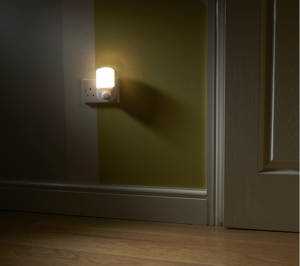Nightlights
Nightlights are small, low-powered electrical light source placed for comfort or convenience in indoor areas that become dark at night.
Facts and Figures
- Before they were powered electrically, nightlights were usually long-burning candles placed in fireproof metal cups, known as tealights in some countries. (Tealights in the U.S. refer to very short and wide candles that can be purchased within or without an aluminum tin cup that are commonly used inside a decorative glass holder. They are also known as votive candles.)
- There are roughly 90 million nightlights purchased each year in the United States. In 2001 alone, more than 600,000 of them were recalled by manufacturers for safety reasons.
- Defective nightlights can cause fires, burns and electrocution.
Uses
Nightlights are typically installed to create a sense of security and to alleviate fears of the dark, especially for children. They also illuminate the general layout of a room without causing the eyestrain created by a standard light, helping to prevent tripping down stairs and over objects. This is an important safety measure for older adults, for whom falls are the leading cause of injury-related deaths, according to the National Association for Home Care and Hospice. Nightlights may also be used to mark an emergency exit.
Types
A wide variety of nightlights is available to homeowners; bulbs vary from incandescent to energy-efficient options, such as light-emitting diodes (LEDs), neon lamps, and electroluminescent bulbs. Some of these devices are equipped with a light-sensitive switch that activates the light only when it’s dark enough for them to be required, saving electricity and the effort needed to manually turn them on and off. Some designs also incorporate a rechargeable battery so they will continue to function during power outages.
Hazards
Nightlights present the following hazards:
- Nightlights can become excessively hot, causing them to melt and pose a risk of fire if they come in contact with flammable materials, according to the U.S. Consumer Product Safety Commission (CPSC). The CPSC receives roughly 10 reports annually of fires that were caused when nightlights ignited toilet paper, pillows, bedspreads and other flammable materials.
- A falling blanket or pillow case can start a fire when they come in contact with a hot nightlight.
- Place nightlights a safe distance from bed coverings, curtains, and other potentially flammable objects and materials. Nightlights should not covered with tape, cardboard or any other material that might cause them to overheat.
- So-called “bubble” nightlights are special, decorative nightlights that contain a dangerous chemical called methylene chloride. If the vial breaks, the unit should be thrown away immediately and precautions should be taken to avoid skin contact with the leaking chemical; and
- electric shock. Nightlights pose the risk of electric shock when used outdoors or in locations that may become wet, such near sinks, hot tubs, in garages, and at covered patios. They should never be plugged into an extension cord, surge-protector strip, multiple-outlet strip, or other movable types of receptacles. Electric shock is also possible if the nightlight overheats and melts.
Additional Tips
- Plug the nightlight into an exposed wall outlet where it will be well-ventilated.
- Do not repair any nightlight yourself. Only replace the bulb.
- Avoid installing nightlights in locations where they might be exposed to excessive sunlight, as UV rays will degrade the plastic.
- Never let children handle nightlights. If you have small children, avoid purchasing or installing a nightlight decorated with cute or funny figures to which they may be attracted and that may be easy for them to reach.Scott Price-Certified Master Inspector
Home Run Inspections
405-905-9175
Info@HomeRunInspections.com
We cover all of the bases! - Serving: Oklahoma City, Norman, Yukon, Edmond, Piedmont, Bethany, El Reno, Tuttle, Mustang, Moore, Norman, Midwest City, Del City, Choctaw, McCloud, Shawnee, Harrah, Newalla, Jones, and more.
- Online at:Home Run Inspections
Follow us on
Like us on FaceBook
Follow us on TwitterFollow us on Instagram: Instagram




